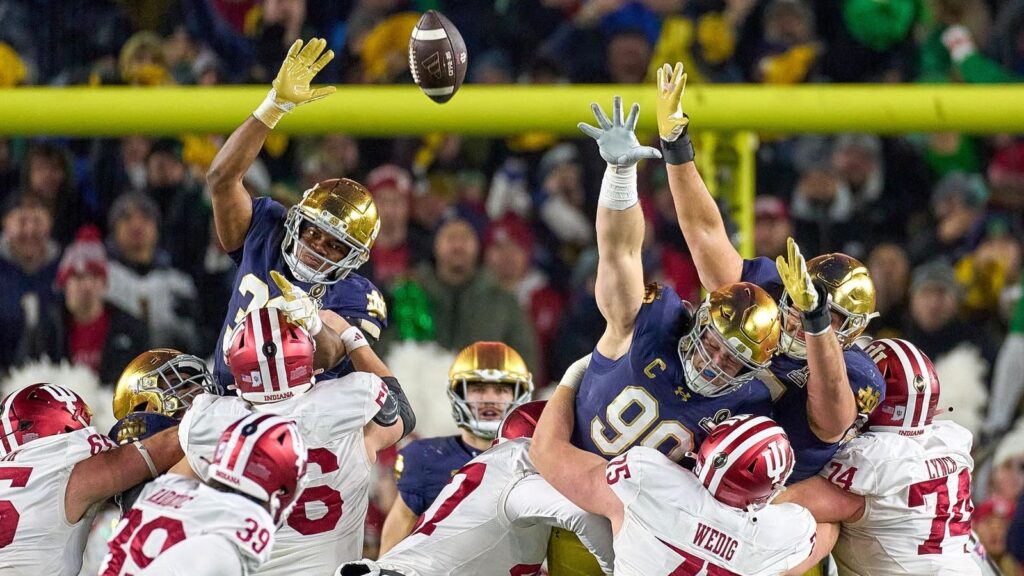SOUTH BEND, INDIANA – DECEMBER 20: Notre Dame Fighting Irish defensive lineman Rylie Mills #99 and … [+]
The College Football Playoff debuted its new 12-team format this weekend, featuring four first-round matchups between some of the nation’s top programs. Playoff team expansion and first-round byes are among the latest changes that bear similarities to the NFL structure. Additionally, adjustments have been made to college football rules that more closely align with the NFL game, including the addition of an extra timeout and a two-minute warning. In many ways, the framework of college football has evolved into more of a professional model. Although there will always be opposition to change, college sports have entered a new era defined by transience, athlete empowerment, and business acumen rather than the traditional amateur ideal.
In the past six to seven years, college sports have undergone a seismic shift due to significant legislative changes. These alterations have profoundly impacted the business environment for all stakeholders involved. In 2018, the NCAA launched the transfer portal, designed to streamline the transfer process, enhance transparency, and empower student-athletes. As a result, college athletes no longer need to seek permission from coaches to change programs. The transfer portal functions as a form of free agency for college athletes. However, pro athletes often sign multi-year contractual agreements, whereas college athletes operate with year-to-year autonomy.
Nearly three years after the introduction of the transfer portal, the NCAA approved an interim policy on name, image, and likeness (NIL) in 2021, allowing college athletes to financially capitalize on their personal brands. The NCAA had long opposed such a policy but was compelled to change its stance due to a key U.S. Supreme Court ruling and the enactment of NIL laws in multiple states. Subsequently, college athletes now have the freedom to act as entrepreneurs, pursuing income-generating opportunities with minimal regulation, while universities engage in bidding wars for talent. For example, college quarterbacks can now land multi-million dollar NIL deals. To attract top talent, university athletic departments work together with NIL collectives, which are independent organizations that raise funds from alumni and donors.
Alongside the NIL policy, conference realignment emerged as another major development in 2021 and continues to influence the landscape today. These changes were primarily initiated by the Football Bowl Subdivision (FBS) and initially involved ten conferences. Notable cross-country moves, such as USC and UCLA joining the Big Ten, were largely motivated by the desire of athletic departments to benefit financially and secure lucrative television contracts. Consequently, conference realignment has resulted in extensive travel for college athletes and significant time away from campus. The travels are often likened to business trips for college football programs in Power Four conferences.
As with most businesses, revenue generation drives college football. According to online marketplace TickPick, the recent in-state rivalry matchup between Texas and Texas A&M averaged $1,072 per seat, which was the most expensive game ever in college football and more costly than any regular season game in NFL history. In the first game of the college playoffs, Indiana played at Notre Dame Stadium, a historical college football venue. Seat Geek indicated there was not a ticket available in the stadium for under $436. Known as the arms race, athletic departments are spending an exorbitant amount of money to boost its recruiting power. The college football arms race does not only pertain to landing five-star quarterback recruits. There are eight college football stadiums that have a capacity of over 100,000 and several that exceed the size of NFL stadiums. NFL teams continue to build larger stadiums with higher price tags, and college football programs also invest large sums of money into their facilities in an attempt to recruit top talent. The “spend money to make money” approach relates to the idea that athletic departments must invest funds in order to yield financial return.
Recently, CNBC listed the 75 most valuable college athletic programs and included four programs that were valued at over $1 billion. Ohio State was first on the list with a $1.32 billion valuation. Football accounts for the majority of revenue for most athletic programs. There have been discussions centered on private equity possibly purchasing stakes in conferences and venture capitalists owning majority shares of college athletic programs. Marc Lasry, former co-owner of the Milwaukee Bucks, forecasted the future of college sports and stated in a recent interview that he believes “a number of schools will sell their teams” to private investors.
Another new direction for college sports that resembles a professional model is the latest proposal of a revenue sharing plan for the 2025-26 academic year. Under this new structure, universities are projected to distribute between $20 million and $30 million of their revenue to athletes. This could lead to collective bargaining in college sports, which would strongly correlate with pro sport labor systems.
CHAPEL HILL, NORTH CAROLINA – DECEMBER 12: Head Coach Bill Belichick of the North Carolina Tar Heels … [+]
From a leadership standpoint, college football is becoming an attractive employment alternative to the professional game. In an unexpected move, legendary NFL coach and future Hall of Fame inductee Bill Belichick accepted a college head football coaching position at North Carolina earlier this month. In a recent ESPN interview, Coach Belichick expressed similarities between college and professional football and spoke about his goal of helping college athletes “develop their careers” within his program. Another move toward the professionalization of college football is the advent of the general manager position in the leadership structure, whose primary role is to oversee personnel and scouting departments.
There are several connections that can be made between where college football is headed and the current NFL structure. Change always brings critics but also provides opportunity. More changes are sure to come, which continues to force those in leadership positions to adapt if they want to excel in this new college football environment.


